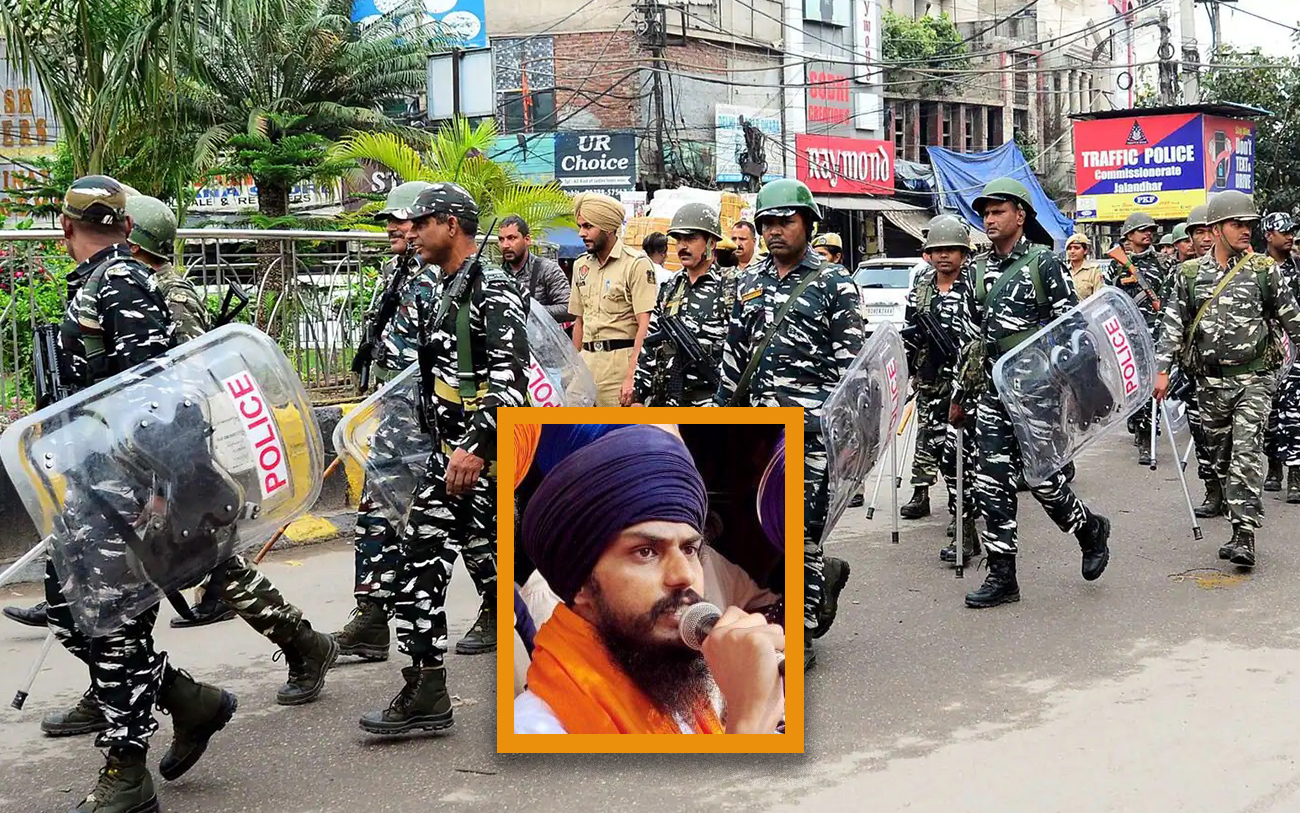India has Turned a Manhunt Into Mass Repression. Journalists Need to Ask Why
- As several countries slide toward fascism, journalists' questions become more necessary and urgent.

In recent weeks in Punjab, in northern India, the government shut down the internet for 27 million people and denied them the right to assemble freely.
Why?
Because the Indian government has decided that capturing Amritpal Singh, a 30-year-old Sikh political activist, is more important than people’s human rights.
Singh (no relation to me) openly airs his grievances about India’s disenfranchisement of Sikhs, as well as injustices committed by the government against other minorities in India. In his advocacy, he has raised the possibility of creating a nation-state for Sikhs from their historic homeland of Punjab.
Last month, as part of a larger campaign to protest what he said are wrongfully detained Sikh prisoners, Singh led a contingent to a police station in Punjab to demand the release of a member of his organization, Waris Punjab De (“the heirs of Punjab”). The confrontation turned violent, and afterward protesters claimed police officers had charged them with batons; the police said it was Singh’s group that instigated the violence.
Whatever the reality, the Indian state took the incident as cause for a manhunt for Singh and to arrest more than 100 others. India has also taken the occasion to abuse fundamental human rights, including severe restrictions on freedom of assembly and freedom of expression. The government shut down internet communications and text messaging across Punjab, which, by itself, the United Nations Human Rights Office said undermines a range of human rights.
Rather than focus on the government’s repressive tactics, most news coverage of the lockdown — in India and abroad — has centered on Singh’s political views. This is not surprising. A dashing but possibly dangerous religious leader evading a region-wide manhunt makes for a good story. But reporting on it can lead journalists to accept government narratives about the original violence and its response to it.
For each of the past five years, India has led the world in internet shutdowns, with at least 84 shutdowns in 2022. The internet enables free expression and exchange and is key to the functioning of modern democracies.
Most importantly, the drama shifts attention from people who are suffering human rights abuses. The current news coverage is so enthralled by the story and spectacle of a perceived national security threat that it neglects to question those narratives or consider the full dimensions of the events. Journalists can and must do better.
I’ll confess, I don’t know much about Amritpal Singh. All I had really heard about him before this month is that he was a Sikh activist devoted to mitigating drug abuse in Punjab. I understand he has become an influential leader in Punjab over the last year and has reportedly led marches of thousands of people. But India’s overwhelming response to the police station clash suggests that, to the state, his growing influence represents a dire and immediate threat.
This response should be familiar to reporters. Labeling someone a violent anti-national has become a recurring strategy in quelling political dissent in India. Just two years ago, I wrote about the Indian government’s frequent use of anti-national rhetoric to justify human rights violations and defame social protests, including nationwide protests against the Citizenship Amendment Act, which codified discrimination against Muslims, and the yearlong farmers’ protests, which also began in Punjab, largely among Sikhs.
It should be obvious from current events that the Indian government’s commitment to democratic norms wasn’t that robust in the first place. Imagine if the U.S. government cracked down on the entire state of Texas (whose population is about the size of Punjab), suspending democratic rights and putting thousands of troops on the street, in order to conduct a search for one person.
Equally revealing are the other activists the police have detained in Punjab in recent days, who include the respected human rights lawyer Jaspal Singh Manjhpur. If this was really about a single individual, why would the government arrest those who speak out against human rights abuses?
The police actions in Punjab are reminiscent of the massacre of Sikhs in June 1984. After imposing a media shutdown, the Indian military launched a large-scale attack on Darbar Sahib of Amritsar, the most significant site for Sikhs, purportedly to flush out a Sikh leader, Jarnail Singh Bhindranwale. The operation resulted in the deaths of thousands of Sikh worshippers, including women and children, the detention of thousands more and the destruction of historic Sikh sites and artifacts. Forty other Sikh gurdwaras were attacked.
Why? To capture one man?
In the 1980s, the Indian state controlled the media, and therefore the narrative — there was only one news channel, and it was government-run. Today, we have dozens of outlets, hundreds of journalists and access to social media. There’s no reason we should be limited to the state’s version of events.
As countries and leaders in many places today continue their rapid slide into fascism and despotism, journalists’ questions become more necessary and urgent.
The world knows that India is currently engulfed by right-wing nationalism and is promoting a supremacist worldview that enables dehumanization of minorities. Keeping this in mind, it’s not difficult to connect the dots to the strategies the Indian state uses to strengthen its hold while weakening dissent. To a keen observer, the formula is apparent:
First, limit the possibility for sharing information. Today, this often means shutting down the internet. For each of the past five years, India has led the world in internet shutdowns, with at least 84 shutdowns in 2022. The internet enables free expression and exchange and is key to the functioning of modern democracies.
Next, spread misinformation. Stoke fears through rumors, lies and propaganda to create mistrust within and among communities. Invoking religious fanaticism and activating people’s fear of political instability is especially effective. Ensure that anyone not buying into the regime’s mythology is punished.
Lastly, keep each community’s repression and its particular story discrete. Don’t let people see the operating framework that is being used against multiple communities; in India’s case, against Muslims, Christians, Sikhs and so many others. When done well, people will have no idea that the same strategies are being used similarly to pacify different communities.
What’s remarkable is that accomplished, well-trained journalists fall for this formula. I have seen little reporting on why Punjab’s Sikhs have mistrust for the Indian state, why the government is censoring journalists, or the human rights abuses that bring legitimate concerns about state violence.
The least the journalist community can do is what they are trained for: Dig beneath the superficial, connect the dots and ask tough questions of authority.
When we fail to do that, it’s not just a failure to the profession. It’s a failure to serve those amongst us who need us the most.
(This story was first published in Religion News Service and republished here with permission.)
Simran Jeet Singh is a scholar and historian of religion currently based at Union Seminary. He is a Senior Adviser for Diversity and Inclusion at YSC Consulting, a 2020 Equality Fellow with the Open Society Foundations, and a Senior Fellow for the Sikh Coalition.



The situation in India regarding the ongoing protests and crackdown on dissent is certainly concerning. The Indian government’s approach to dealing with dissent and protests has been criticized by many, including journalists and human rights organizations. The recent arrest of activists and journalists, as well as the use of sedition charges, shows a worrying trend towards the suppression of free speech and the silencing of critical voices.
Journalists have a crucial role to play in uncovering the truth and holding those in power accountable. They must continue to ask tough questions and investigate the government’s actions to shed light on what is happening in the country. It is important that they report on the situation accurately and objectively, without fear or bias, to ensure that the public is informed about what is happening and can make informed decisions. The press must be allowed to function freely and without interference to ensure a healthy democracy.
About Us:- Hindu University of America Certificate Program in Sanskrit through the Yoga Shaastram provides an alternative route to achieving Sanskrit Proficiency.
Know More >> https://www.hua.edu/
This statement is not from Hindu University of America. Can the author of this post put their name or post as anonymous?
-Ankur Patel
Director of Advancement at Hindu University of America